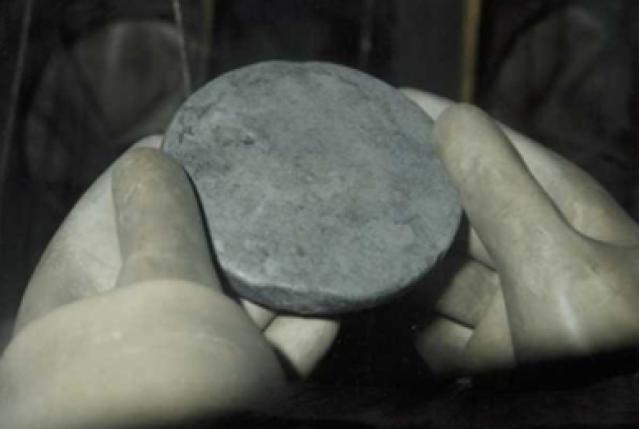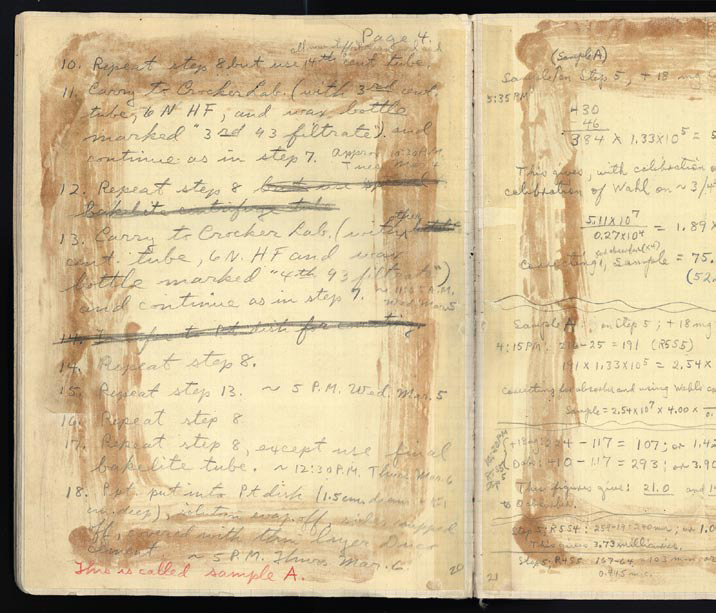Hands on laboratory work...Glenn T. Seaborg style
This is somewhat of a rare opportunity to read how original experimental laboratory work is performed. Specifically, Glenn T. Seaborg's research work with heavy isotopes at Berkeley University in the early 1940's and more specifically the discovery of plutonium.

Plutonium
logbook: plutonium
"Atomic element 94 was named "plutonium" after Pluto, the ninth planet from the Sun (now demoted to "minor planet" status.) By tradition, plutonium should have been assigned the symbol "Pl," but co-discoverer Glenn Seaborg gave it the symbol "Pu" as in "pee-yew," dark humor that reflected the element's potential use.
Since plutonium is not found in nature, it had to be created in the lab. This was accomplished in 1941 at the Berkeley Radiological Laboratory by Seaborg, Edwin McMillan, J.W. Kennedy, and Andrew Wahl, using the 60-inch cyclotron there.
Now the group hoped to find a particular isotope of plutonium, Pu-239. Like other forms of plutonium, it was expected to sustain fission, a process that splits atomic nuclei in a chain reaction that releases tremendous amounts of energy. And there was reason to think it could be isolated in the quantities needed to build a nuclear weapon.
They would begin by producing neptunium-239, another human-made element that had been discovered at the lab just a year before. The plan was to chemically purify it and allow it to decay into plutonium-239.
These pages from Seaborg's notebook contain instructions that the scientists checked off as they went along. It was a laborious, time-consuming process that required carrying samples from lab to lab on campus. To minimize radiation exposure, researchers wore lead gloves and carried the material in lead beakers inside wooden boxes.
On Thursday, March 6, 1941, a purified sample of neptunium-239 was placed in a lab dish and covered with a thin layer of Duco cement. "This is called sample A," Seaborg wrote, triumphantly, in red. The team documented its transformation, through natural radioactive decay, into Pu-239, and they determined that it underwent fission much faster that uranium does.
In May 1942, Seaborg, Kennedy, Wahl, and collaborator Emilio Segr� sent a letter describing the work on Pu-239 to Physical Review, where it was held for publication until after the war.
On Aug. 9, 1945, a nuclear bomb powered by Pu-239 exploded over Nagasaki."
Symmetry, Volume 4, Issue 6, August 2007

"Early History Of Heavy Isotope Research At Berkeley" by, Glenn T. Seaborg
- Hanford Nuclear Reservation Container Tanks Leaking...about 300 Gallons A Year
At a grocery near you soon. "Washington State nuclear waste tanks 'leaking'" February 23rd, 2013 BBC NEWS Six underground storage tanks at a nuclear site in the US state of Washington are leaking, authorities say. Governor Jay Inslee described...
- Deceased--albert Ghiorso
The codiscoverers of nobelium [No, element 102] in the HILAC building, LBL in 1958:Albert Ghiorso, Torbjorn Sikkeland, and John R. Walton. Glenn T. Seaborg is absent. Albert Ghiorso July 15th, 1915 to December 26th, 2010 "Albert Ghiorso dies at 95; engineer...
- Synthesis Of Element #117 Achieved
"Russian Physicists Synthesize New Superheavy Element 117" by Alexandra Witze April 6th, 2010 Wired Physicists have reported synthesizing element number 117, the latest in the quest to create artificial “superheavy” elements in the laboratory. A...
- Emilio Gino Segrè--early Atomic Physics
Emilio Gino Segrè February 1st, 1905 to April 22nd, 1989 One of those physicists of relative unknown status during the infancy of atomic physics. He is credited with the discovery of the first artificially synthesized chemical element not occurring...
- Enrico Ferimi And Winnie The Pooh
Nothing to be ashamed about...Enrico Ferimi liked Winnie the Pooh. I'm sure we all have a fondness for something that may be a a little bizarre. "The role Winnie the Pooh played in the atomic bombing of Japan is not widely known. But when Enrico...
